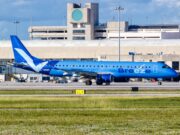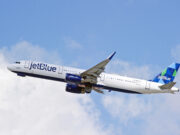
Pilots around the world are taught from day one that the left seat is a place of authority and leadership. When a pilot steps aboard, enters the cockpit and turns towards the left, it is a symbolic moment. This individual is assuming command of the aircraft before them, big or small, tall or short, jet or prop, with cargo or passengers. Regardless of the ship, it now rests in the capable hands of its captain, no matter how brief that moment in time may be.
But what of that other seat? In that often-overlooked perch sits a fellow pilot, one equally commendable. This is a great seat – AWESOME, in the true Merriam-Webster meaning of the word. This is a seat many in the world can only dream of occupying. This is a place where you always have a front row view to all the action, and more. Why should it be any less? For every aviator, this is a place we come to learn, to grow, to observe, and to practice. But why not to lead?
Each member of a flight crew is equally integral to the safe, successful completion of every flight. Sometimes however, from the aircraft’s right, we feel a little less “in the hunt” or important. It’s funny how just a few feet of lateral distance can make such a huge difference.
In my research on the topic, I have yet to discover any decree that states one must have a specific title in order to be a leader. My own discovery has made it apparent that we take advantage of too few opportunities to lead from the right seat. I’m not necessarily talking about making command decisions (at a fraction of a legacy 121’s captain’s pay) and I’m obviously not suggesting we say, “death be to law and order,” and create anarchy in the carefully architected cockpit. Instead, I’m talking about inspiring your crew while promoting a strong, competent, symbiotic partnership. Often, we’re offered plenty of opportunities to build one another up and keep the ship right. A second set of eyes, from those few feet to the right, can bring in a fresh perspective or offer an encouraging, confidence-inspiring sign of agreement. You are as great a leader as any when you cooperatively take initiative, take responsibility and take ownership from the right seat. Being a proactive pilot from the right often steers your aircraft in such a way that whomever is on the left may begin to look in YOUR direction. It is easy to spot a “superior” (four bars notwithstanding) but, if you pay attention, it can be even easier to identify a leader. “Leading from behind” allows you to uplift those around you – personally, emotionally and professionally. Nelson Mandela put it so eloquently; “It is better to lead from behind and put others in front, especially when you celebrate victory when nice things occur.”
In the 121 world, one must find the balance to lead from the right. It requires patience, finesse and acuity. You’re not running the show, but you’re putting forward your “best stuff” to help move the whole team forward – as every great leader should.
Outside of 121, we find an interesting set of circumstances. Based on common “seat swap” practices, wherein the PIC (pilot in command) and the SIC (second in command) actually exchange seats, the PIC isn’t always the one occupying the left seat. This pivotal time is indicative of changes – the most important of which is that PIC now assumes the role of PM (pilot monitoring.) The PIC’s role becomes that of a supportive, obedient crew member and mentor. In every GREAT captain you’ll find a great teacher – not a teacher like the one who brought candy to class or gave you an extra 15 minutes of recess on Fridays, but the teacher who guides you to become your best self. These extraordinary teacher/mentors are the unsung heroes and heroines of aviation. This sometimes thankless and oftentimes exhausting role is often taken for granted. Think about what makes that variety of captain great. They still lead from the right seat, not like a dictator in a totalitarian regime, but rather offering guidance, promoting decision making and building up their colleagues. In my opinion, this is the hardest job a captain has. One has to walk a tight rope, acting as the PM while giving the pilot flying (PF) the chance to improve their skills and continuously develop and grow. A good leader knows when to stay quiet (both verbally and with body language), and that is sometimes the hardest part. A good leader doesn’t just know the right thing to say – they know the right times to say nothing.
I don’t mean to imply that such a relationship does not exist in the airline community, because obviously, pilots do trade PM/PF duties. My hope is to emphasize how that symbolic switch from seat to seat can really “turn it up a notch” for those proving their mettle in 91 and 135.
Think about what kind of leader you are. Now, consider how you can become a better leader, and in turn, a better follower. Recognize the opportunities you’re given and execute each at 100%. Real leaders don’t need a title or four stripes on their shoulders – real leaders adapt and excel, propelling their team to great heights, regardless of where they sit.






















































